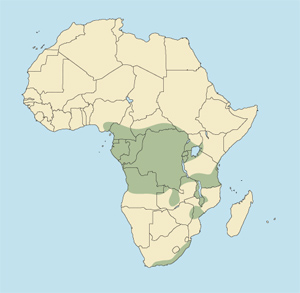 |
Cephalophus monticola
Duiquer azul (Sp), Blauducker (G), Céphalophe bleu (F), Blouduiker (Af). The blue duiker is not actually blue, but in some areas the coat takes on a faint bluish sheen when viewed in certain lights.
DESCRIPTION Shoulder height 11-13 inches (28-33 cm). Weight 8-10 pounds (3.5 to 4.5 kg).
The blue duiker is the smallest of all duikers, a very small, grayish antelope with a sleek coat and tiny horns. The general color varies regionally from slate gray to dark brown, with the legs the same color as the body, or sometimes tinged with red or reddish fawn. The underparts vary from pure white to slightly lighter than the upperparts. The buttocks are whitish, contrasting with the body color. The bushy tail is dark on top and white underneath. The head tuft is very short or absent. There is a light-colored streak above the eyes. As in the Maxwell duiker, the openings of the facial glands are curved, not straight as in other duikers. There are pedal glands between the hoofs, but no inguinal (groin) glands.
Both sexes have horns except in the subspecies musculoides (western Kenya) and aequatorialis (northern and northeastern Congo [K], extreme southern Sudan, Uganda, and northern and northwestern Tanzania) where females are hornless. The horns are very short, heavily ringed at the base, set at a slight angle above the plane of the face, and curved slightly forward and inward at the tips. Females are slightly larger than males and, in areas where they grow horns, their horns are smaller than those of the male.
The blue duiker may be distinguished from the Maxwell duiker by these characteristics: (1) It is about half as large, weighing 8-10 pounds (3.5 to 4.5 kg) as compared to 17-20 pounds (8-9 kg) for the Maxwell; (2) the rump area is whitish, whereas in the Maxwell it is the same color as the body; and (3) the pedal gland has a simple opening, whereas in the Maxwell the gland is in a subcircular sac at the end of a narrow canal.
HABITAT Forests and thick bush, including thickets in relatively open country.
DISTRIBUTION Widespread throughout Africa in suitable habitat south of the Sahara and east of the Niger River in Nigeria. West of the Niger River in Nigeria, and in West Africa, the blue duiker is replaced by the Maxwell duiker. Reports of the blue duiker occurring in West Africa are unverified.
TAXONOMIC NOTES Some authorities believe the blue and Maxwell duikers constitute a single species, with geographical variations between populations in western, eastern and southern Africa. Most, however, consider them separate species, and that is our position here. Ansell lists 16 races of blue duiker, which we do not separate: aequatorialis, anchietae, bicolor, congicus, defriesi, fusicolor, hecki, lugens, melanorheus, monticola, musculoides, pembae, schultzei, schusteri, simpsoni and sundevalli.
|





